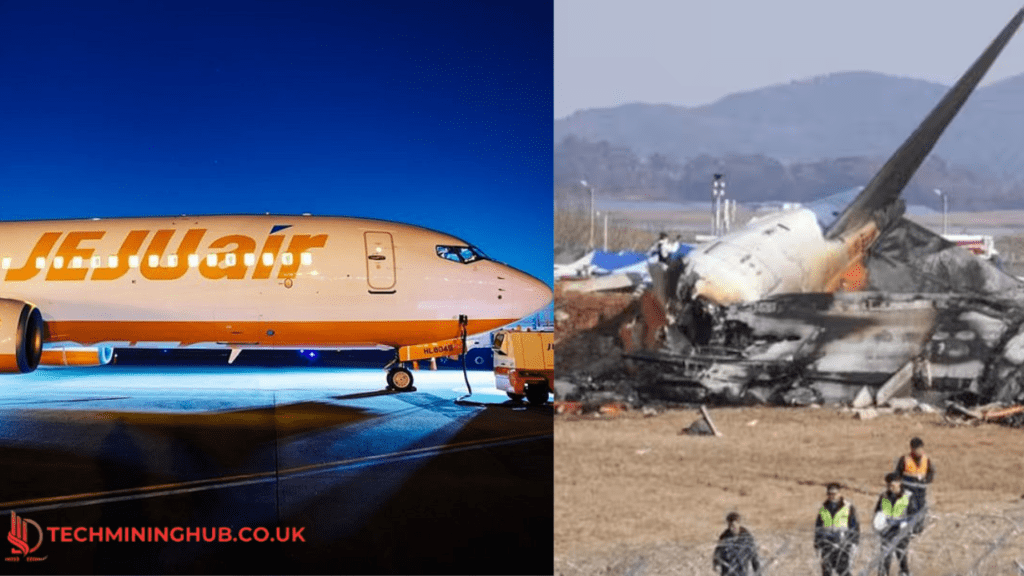The tragedy of the crash of Jeju Air has stunned South Korea and the international aviation community with unanswered questions. 172 passengers and crew members onboard the ill-fated aircraft lost their lives when the plane crashed near Jeju Island. As investigators race to piece together the puzzle of what went wrong, one disturbing detail has come to light: the black boxes onboard stopped recording four minutes before the crash. This revelation has clouded efforts to learn the facts about the disaster and renewed arguments on aviation safety.
The Incident: A Timeline of Events
In a typical business traveler- and tourist-crowded Gimpo flight, Jeju Air flight JA123 had departed from the airport on its way to Jeju Island. The flight was on a normal course when approaching Jeju Island, but with strong crosswinds and heavy rain. According to survivors’ accounts, the plane was hit by intense turbulence before the crash.
At 9:30 Air traffic controllers lost communication with the flight at 34 PM local time. Only shortly thereafter was radar data found to show that the aircraft had deviated from its assigned altitude and trajectory. A few moments after that, the plane was no longer even showing up on radar. The pilot contacted emergency responders immediately, and search and rescue operations started; however, the plane had already hit the waters of the island’s coast.
The Black Boxes: A Critical Component
Every modern commercial aircraft is equipped with two black boxes: the Flight Data Recorder (FDR) and the Cockpit Voice Recorder (CVR). They are meant to deliver amazing data for investigators who investigate an aircraft accident. What the FDR sightings do is record altitude, speed, engine performance, flight control, etc., and what the CVR records are cockpit conversations between pilots, air traffic controllers, and any other sounds in the air.
In Jeju Air flight JA123, the black boxes were recovered in just 48 hours after the crash. But investigators were stunned to discover both devices had stopped recording four minutes before the incident. The rarity and the depth of this anomaly are deeply troubling, as it is a key gap in the data that is needed to understand what happened.
Possible Causes for the Black Box Failure
Several theories have emerged to explain why the black boxes stopped recording:
- Electrical Failure: The black boxes could have suffered a catastrophic electrical failure, but the devices are mechanically robust and failures like that are very rare.
- Physical Damage: It is possible the black boxes are affected by a structural failure onboard the aircraft. Preliminary inspections did not find damage to the devices themselves.
- Software Malfunction: It could have been a glitch in black box software that prompted it to stop recording prematurely. The manufacturers of the devices are looking into this possibility.
- Deliberate Interference: Even while highly speculative, some experts have ascribed their possibility to deliberate tampering, possibly by someone onboard or perhaps from outside the ship.
Challenges for Investigators

But there’s a big hurdle for investigators—the lack of the final four minutes of data. In particular, those last moments can be critical in what happens next, in determining the sequence of events that get us off track and into a crash. Without this data, experts are reliant on secondary information, radars, witness statements, and the physical wreckage of the aircraft.
To mitigate this challenge, the investigation team is employing advanced forensic techniques, including:
- Simulation Analysis: From the time you have flight data until you stop recording it, we use that to build computer simulations trying to predict what might have happened during the last moments.
- Wreckage Examination: Looking at the scrapped parts of the aircraft to find mechanical failure or external damage.
- Survivor Testimonies: Sought out for firsthand accounts about the flight’s ending for the passengers that survived the crash.
Aviation Safety Implications for Broader.
This thesis presents broader implications for aviation safety.
The fact that black boxes are viewed as the gold standard for aviation accident investigation, however, begs a serious question regarding their reliability. However, such failures occur exceedingly rarely and underscore the need for improvements in technology.
A few experts call for real-time data streaming as an addition to traditional black boxes. This technology can transmit critical flight data to ground stations in real time so investigators have access to the data—even if black boxes are compromised. But producing such systems at such a large scale would amount to an enormous investment and would also need to be regulated.
The Path Forward
Authorities are also working to prevent future incidents as the probe into Jeju Air flight JA123 continues. This includes:
Enhanced Maintenance Protocols: Making sure all onboard systems, like black boxes, are rigorously tested and maintained.
Improved Pilot Training: Piloting advanced training for pilots to better handle unforeseen adverse weather conditions or emergencies.
Policy Revisions: To examine the gaps found by the crash in terms of safety regulations.
The South Korean government has pledged to leave no stone unturned as it seeks answers, taking a close look with international aviation experts to determine the truth. Jeju Air has meanwhile grounded its fleet of similar aircraft as a precaution.
FAQs
1. What are black boxes, and why are they so important?
Aircraft flight data (FDR) and/or cockpit audio (CVR) recording devices used as black boxes. Importantly, they are used to answer investigative questions about the final moments of any flight, and in the case of aviation accidents, provide important detailed information.
2. So why did the Jeju Air flight JA123 black boxes stop recording?
The reason for the exact car fire remains under investigation. Reasons can be electrical failure, physical damage, software malfunction, or deliberate interference.
3. But how will investigators proceed without the final four minutes of data?
The information dependent on the secondary sources, like radar data, debris analysis, and survivor’s testimony, will be used by investigators. The missing data may also be reconstructed with the aid of advanced simulations.
4. Are black box failures normal?
Black box failures, however, are quite rare. They are designed to be extremely durable and reliable within extremely tough conditions.
5. Was this crash preventable?
It’s too early to determine. Future safety measures to help prevent a repeat from happening will no doubt be informed by the findings of the investigation.
6. How is aviation safety improved?
These include looking at real-time data streaming tech, more robust maintenance protocols, and more elaborate piloting technology.
Jeju Air crash et al. is yet another reminder of the problems of modern aviation and just how important safety measures should be. In the meantime, as the world awaits answers, the lessons to which this tragedy may contribute are likely to shape the future of air travel for years to come.



